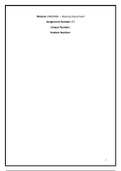Module: HBEDABH – Hearing Impairment
Assignment Number: 03
Unique Number:
Student Number:
1
, Contents
Title Page Number
Cover Page 1
Contents 2
Introduction 3
Question 1- 4-7
Defining and describing hearing impairment
Question 2 - 8
Early identification and intervention
Question 3 – 9
Amplification
Question 4 – 10-13
Language and communication choices
Question 5 – 14-16
Educational options for the Deaf learner
Question 6- 17
Issues in assessment
Conclusion 18
Bibliography and list of sources 19
TURNITIN Report
2
, Introduction
One of the most rampant disabilities is deafness according to (Swanepoel, Storbeck,& Friedland,
2009), as stated in (Storbeck, 2011, pg. 382). It is misunderstood and an underestimated invisible
impairment. The impact upon the child and their family are underestimated.
According to (Storbeck, 2011, pg.383), deafness is usually described as “the sensory impairment of
not being able to hear, and visually brings to the mind the need for hearing aid, speech therapy
and the use of signing and gestures as a means of communication.”
People usually visualise it with terms such as “deaf and dumb”, “hearing impairment”, “learning
disabled” and “intellectually disabled”.
Researchers around the world are moving away from disability labelling and are using the term
“deafness” to refer to broad, and all levels of hearing loss, according to (Storbeck,2011, pg 383).
This will lead to the distinction of deaf and hard of hearing individuals according to
(Storbeck,2011,pg 383).
The two terms are defined according to (Storbeck, 2011, pg 383): “deaf learners” refers to the
audio logical aspect of having a hearing loss and “Deaf learners” refers to the linguistice and
cultural minority group(Padden&Humphries,1988).
There are two school of thought according to (Storbeck, 2011, pg 383):
1. Audiologically – deaf people are seen to lack hearing and their communication ability are
thus effected( deficient). (Storbeck, 2011, pg 383).
2. Linguistic Minority Group – a strong deaf identity and culture( Storbeck, 2011, pg 383).
It is imperative to note the structure and mechanics of the ear: (Storbeck, 2011, p384)
• The ear id divided into 3 sections – the outer ear, the middle ear and the inner ear.
• Each section has a role to play in the translation of the sound into mechanical energy and
into the electrical impulses interpreted by the brain (Storbeck, 2011).
• The outer ear is the external part of the ear which collects the sound waves and directs
them into the ear.( Hear-it.org, Hearit, 1999).
• The middle ear is between the ear drum and the oval window. It transmits sound from the
outer ear to the middle ear. ( Hearit.org, Hearit, 1999)
• The inner ear converts rhe sound pressure impulses from the outer ear into electrical
impulses which are passed on to the brain via the auditory nerve. ( Hyperphysics).
The following will be observed: defining and describing hearing impairment, early identification
and intervention, amplification.
3






